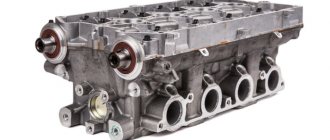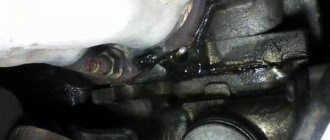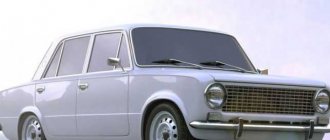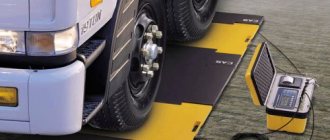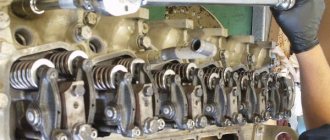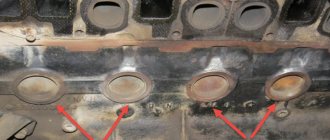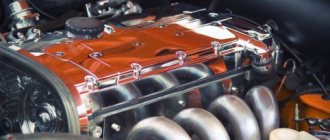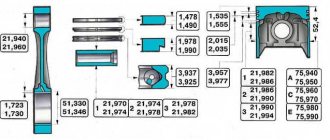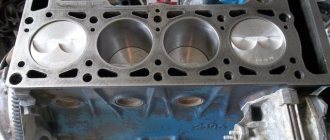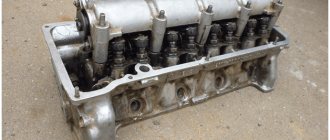Advantages
The technical characteristics of the VAZ 21011 engine were such that very little positive was obtained from the engine. Early development of the domestic auto industry, lack of materials and knowledge - all this affected the design of the engine. But despite this, the advantages of the engine can still be found:
- Very simple design. One of the biggest advantages of the engine is that it can be repaired in any garage. Manufacturers even included in it the possibility of boring cylinders in case of need for major repairs.
- The VAZ 21011 engine capacity of 1294 cubic centimeters made it possible to obtain a compression ratio of 8.5. This is also a positive quality, since the minimum compression ratio makes it possible to work correctly even on gasoline with a low octane number.
- Available and inexpensive spare parts. Domestic power units have never been characterized by difficulty in the availability of spare parts, so you can find spare parts and parts for the 21011 engine in almost any store, and they will cost very little.
FAQ
Fuel consumption - city 9.4l. | track 6.9l. | mixed 9.2l/100 km
Oil consumption - 700 g. per 1000 km
VAZ 2101 engine weight - 114kg
Overall dimensions of the VAZ 2101 engine (LxWxH), mm - 540x522x621
What kind of oil to pour into the VAZ 2101 engine: 5W-30 5W-40 10W-40 15W-40
How much oil is in engine 2101: 3.75 l.
When replacing, fill in about 3.5 liters.
Service life of VAZ 2101: 1. According to the plant – 125 thousand km 2. In practice – 200 thousand km
Source
Peculiarities
Engines 2101 are distinguished by their simplicity of design, which significantly simplifies repair work.
The power unit, unpretentious to use, did not cause any special problems for its owners and could, if provided with proper care, run 150-200 thousand kilometers. It was originally designed to run on low-octane fuel, which significantly reduced the owners' costs for operating the vehicle. The VAZ 2101 engine power of 59 horsepower was enough to accelerate a compact and light car.
In conclusion
“Kopeyka” is rightfully called a legend of Soviet automobile production. People appreciated this car for its reliability, practicality and affordability. This modification has not been produced for a long time, but it can be purchased on the secondary market. There are quite well preserved copies. In addition, the VAZ-2101 represents a limitless field for tuning. Craftsmen “put their hand” to literally all parts of the car, from equipping the interior to modifying the body and power unit.
Source
Specifications
| Positions | Indicators | |
| VAZ 2101 | VAZ 21011 | |
| Type of fuel | Gasoline A-76, AI-92 | Gasoline AI-93 |
| Injection device | Carburetor | |
| Cylinder block material | Cast iron | |
| Cylinder head material | Aluminium alloy | |
| Weight, kg | 114 | |
| Cylinder arrangement | Row | |
| Number of cylinders, pcs | 4 | |
| Piston diameter, mm | 76 | 79 |
| Amplitude of piston movement, mm | 66 | |
| Cylinder diameter, mm | 76 | 79 |
| Working volume, cm3 | 1198 | 1294 |
| Maximum power, l. With. | 64 | 69 |
| Torque, Nm | 87,3 | 94 |
| Compression ratio | 8,5 | 8,8 |
| Mixed fuel consumption, l | 9,2 | 9,5 |
| Declared engine life, thousand km. | 200000 | 125000 |
| Practical resource, thousand km. | 500000 | 200000 |
| Camshaft | ||
| location | top | |
| valve timing width, 0 | 232 | |
| value of the exhaust valve advance angle, 0 | 42 | |
| intake valve retard, 0 | 40 | |
| diameter of seals, mm | 56 and 40 | |
| width of seals, mm | 7 | |
| Crankshaft | ||
| Neck diameter, mm | 50,795 | |
| Number of bearings, pcs | 5 | |
| Flywheel | ||
| outer diameter, mm | 277,5 | |
| bore diameter, mm | 256,795 | |
| number of ring teeth, pcs | 129 | |
| weight, g | 620 | |
| Recommended Engine Oil | 5W30, 15W40 | 5W30, 5W40, 10W40, 15W40 |
| Engine oil volume, l | 3,75 | |
| Recommended Coolant | Antifreeze | |
| Coolant quantity, l | 9,75 | |
| Timing drive | Chain, double row | |
| Cylinder operating order | 1–3-4–2 | |
Tuning
Tuning the VAZ 2101 engine presents certain difficulties. The fact is that the safety margin of the VAZ 2101 engine is not too large, so any intervention in the operation of the power unit and an increase in its power invariably affects the resource.
It is not uncommon for even a relatively simple tuning, which gave an increase of 15-20 horsepower, to lead to the engine failing after 10-15 thousand kilometers. That is why issues of increasing power should be approached as carefully and thoughtfully as possible. All work must be performed by an experienced mechanic.
- The tuning option with an increase in volume involves boring the cylinders and replacing the pistons with spare parts from older VAZ engines. Such work is somewhat difficult and can be expensive. It is necessary to bore the cylinders, replace the pistons and crankshaft. It is often easier to carry out an engine swap by installing an engine from a VAZ five or six.
- Installing a turbine can be considered solely in theory, since this tuning option leads to rapid failure of the VAZ 2101, the engine tuning of which was performed using a turbine and compressor. An engine with an installed turbine has a service life of about 20 thousand kilometers, while the power indicator in rare cases exceeds the 100 horsepower mark. This option is used only for cars participating in drag racing, where car owners do not care about the life of the car, but only the technical characteristics of the forced engine are at the forefront.
Read the author
VAZ 2101 car engine: characteristics, malfunctions and tuning Link to main publication
This is interesting: How many horsepower is in the VAZ 2109 engine
Reliability, weaknesses, maintainability
Reliability
According to reviews from car owners, the VAZ-2101 is a fairly reliable engine. The cast-iron cylinder block and the simplicity of the internal combustion engine design made it easy to troubleshoot minor problems. Unpretentiousness to fuel and oil also emphasized the reliability of the engine.
The manufacturer has set the mileage to 125 thousand km. In practice it is significantly exceeded. With normal engine care, a mileage of 250-300 thousand km without major repairs is not the limit.
Of course, there are many problem areas in the engine (more on this later). But, firstly, most of them are provoked by motorists themselves, and secondly, timely and high-quality engine maintenance completely reduces their negativity to a minimum or completely eliminates it.
Numerous reviews from car owners about the engine also emphasize its reliability. For example, Vovikas from Irkutsk writes: “...the engine runs smoothly, starts with half a turn, drives quickly...”. Alexey from Sarapul draws attention to the excellent engine start in severe frosts: “...confident start at -20֯, good at -30֯...”.
There are fewer negative reviews, but they exist. As already mentioned, many problems arise due to the fault of motorists themselves. Vasily from Syktyvkar confirms: “... the engine spun up to 8000 on the third... the inlet valve was slightly bent in the 4th pot...”.
Comments, as they say, are unnecessary. If someone thinks that a “penny” with its own engine is a car, then it is useless to convince such a driver otherwise.
Proper operation and maintenance make the VAZ-2101 practically indestructible.
Weak spots
It can be stated that there are no pronounced weak points on the engine. Almost all engine problems occur with the help of the car owner.
Inability to start the engine. There are many reasons for this phenomenon. The main ones are malfunctions in the ignition system, fuel pump and carburetor.
Timely elimination of detected problems, timely maintenance and refueling with high-quality gasoline significantly reduce the possibility of starting problems.
Motor overheating. Usually occurs due to a faulty thermostat, dirty cooling system components, or a malfunctioning water pump. Constant monitoring of the coolant temperature eliminates the dangerous consequences of engine overheating.
Unstable operation of the internal combustion engine at idle speed, tripping. Most often, the reason lies in a clogged carburetor.
The problem can be caused by a malfunction in the ignition system (faulty spark plug, unsatisfactory condition of the contacts in the switch-distributor, breakdown of the insulation of high-voltage wires).
Decrease in unit power. Here the problem must be looked for in the fuel pump, carburetor, increased contact gap of the breaker, erroneous ignition timing, misaligned valves. Wear of the CPG also does not contribute to an increase in engine power.
Conclusion: there are weaknesses in the engine, but their negative impact directly depends on the car owner’s attitude towards the engine.
Maintainability
VAZ-2101 is highly maintainable. Car owners note that this engine takes several laps. This is facilitated by the simplicity of the engine design and the cast-iron cylinder block, which can be bored repeatedly.
The engine can easily be repaired on its own in a garage. The availability of spare parts and their low cost coupled with the absence of complex adjustments make the restoration process accessible to almost every car enthusiast.
When selecting parts and assemblies for repair, you need to pay attention to their authenticity. Nowadays, when purchasing, it is very easy to run into an outright fake, and if you use it, you will have to do all the work again.
We are not talking about purchasing a contract engine, since finding a decent copy is quite problematic.
Analogue spare parts are also in short supply. But there is a good opportunity to select the necessary components with slightly modified configurations. Such a replacement can have a positive effect on improving the technical and operational performance of the motor.
For example, replacing a native contact breaker with an electronic (contactless) one improves fuel economy and increases the power of the internal combustion engine.
Thus, there is no doubt about the maintainability of the VAZ-2101.
Maintenance - regulations
A typical internal combustion engine device ensures that the replacement of consumables and maintenance operations are standard for the AvtoVAZ engine family, so the 21011 engine has the following maintenance regulations:
| Maintenance object | Time or mileage (whichever comes first) |
| Timing belt | replacement after 100,000 km |
| Battery | 1 year/20000 |
| Valve clearance | 2 years/20000 |
| Crankcase ventilation | 2 years/20000 |
| Belts that drive attachments | 2 years/20000 |
| Fuel line and tank cap | 2 years/40000 |
| Motor oil | 1 year/10000 |
| Oil filter | 1 year/10000 |
| Air filter | 1 – 2 years/40000 |
| Fuel filter | 4 years/40000 |
| Heating/Cooling Fittings and Hoses | 2 years/40000 |
| Coolant | 2 years/40000 |
| Oxygen sensor | 100000 |
| Spark plug | 1 – 2 years/20000 |
| Exhaust manifold | 1 year |
Consumables and spare parts for the engine are not in short supply, despite its discontinuation in 2006.
Service manual 21011
